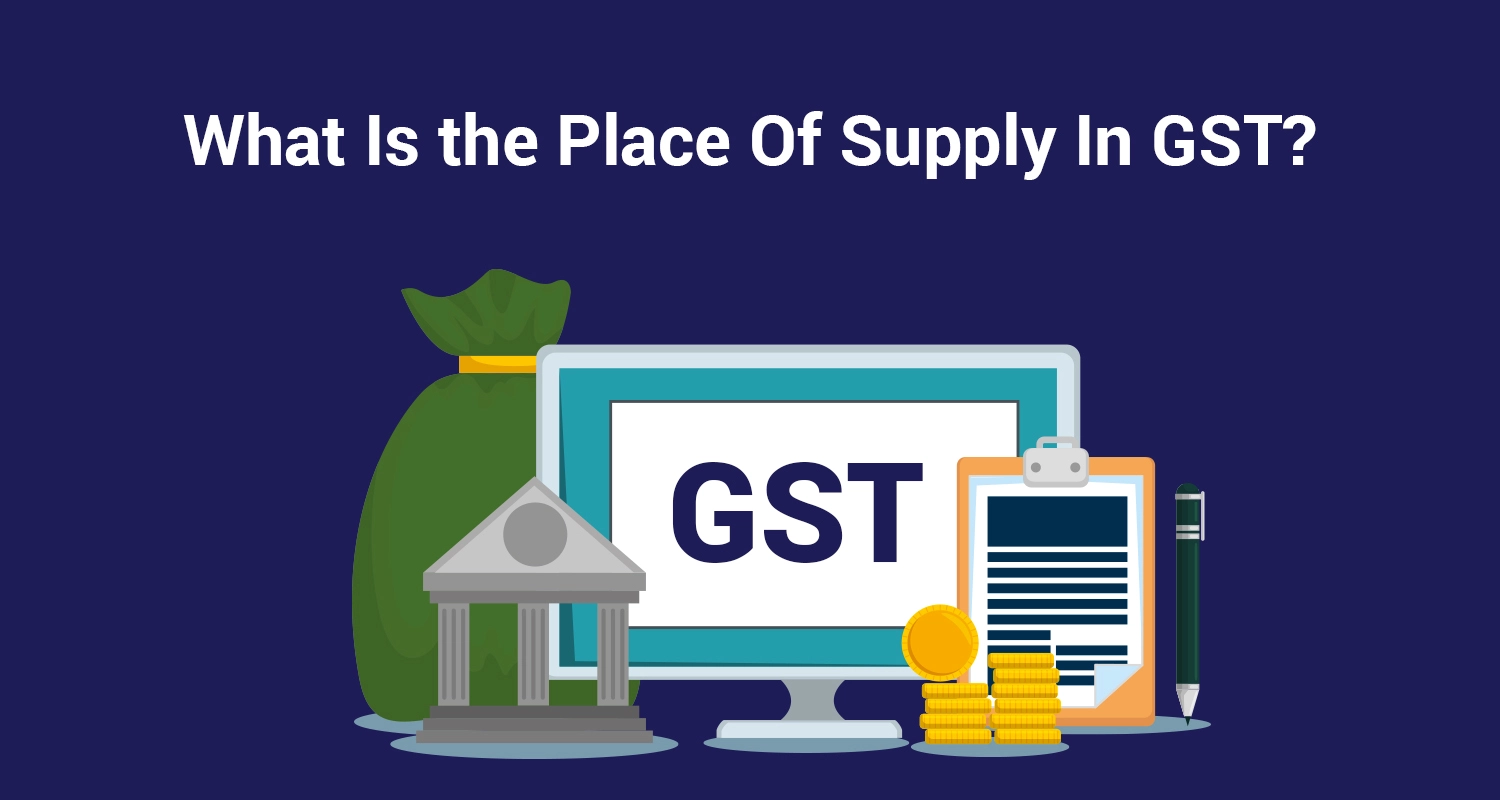What Is Place Of Supply In GST?

2017 brought the Goods and Service Tax into the Indian taxation system. GST is a destination-based tax, meaning it must be paid in the state where products and services are ultimately used. To determine this, it is imperative to identify the place of supply (POS), as it will affect the applicable tax rate. How exactly? Let’s discuss this in detail in this article.
What is the Place of Supply in GST?
As per the GST Law, the place of supply is the place of the recipient of goods or services. Generally, this is the recipient's registered address. Still, certain types of transactions have different rules for determining the place of supply and the tax rate applicable.
Why should we determine the place of supply?
GST is levied in the form of IGST (Integrated GST), CGST (Central GST), SGST (State GST), and UTGST (Union Territory GST). The type of GST you need to pay depends on the nature of your supply, whether it is inter-state and intra-state GST. The answer lies in the transaction destinations. Further, the key factors in identifying the nature of supply are the place of supply and where the supplier is based. Supply can be local or international. Local supply can be within or outside the state, and this applies to both goods and services. The process is salient as it then helps fix the tax rate applicable.
Chapter V of the IGST Act:
The legal framework to determine the place of supply is covered in the fifth chapter of the IGST Act from sections 10 to 14, each dealing with one aspect of the process. The sections are-
- Section 10: Covers the place of supply for goods within India, excluding imported or exported goods.
- Section 11: Deals with the place of supply for imported or exported goods.
- Section 12: Specifies the place of supply for services when both the supplier and recipient are in India.
- Section 13: Applies to services where the supplier or recipient is outside India.
- Section 14: States a special rule for tax paid by those who supply online information and access to databases or retrieval services.
Place of supply rules under GST:
Understanding where a supply takes place determines the type of tax applied. IGST is used for inter-state supplies, while CGST and SGST apply to intra-state supplies. The distinction relies on the locations of the supplier and the place of supply. If the supplier's location and the place of supply are in different states, it's considered inter-state, triggering IGST. Conversely, if both are in the same state, it's intra-state, resulting in CGST and SGST/ UTGST.
Let’s check the different scenarios in defining the nature of supply. So suppose the goods are going from place A to place B.
- Kerala to Bihar: Different states. It is Inter-State (IGST)
- Puducherry to Puducherry: Same state. It is Intra-State (CGST & Puducherry GST)
- Chandigarh to Chandigarh: Same union territory. It is Intra-State (CGST + UTGST)
- Chandigarh to Punjab: Different states. It is Inter-State (IGST)
- Chandigarh to Daman & Diu: Different states. It is Inter-State (IGST)
- Goa to Goa: Same state. It is Intra-State (CGST + Goa GST)
- Karnataka (SEZ) to Karnataka (non-SEZ): Special case. It is Inter-State
Sapna aapka. Business Loan Humara.
Apply NowHow do we determine the place of supply under GST for goods?
When figuring out the place of supply for goods, consider three scenarios:
Movement of Goods:
When goods are movable, the place of supply is where the goods end up for delivery.
No Movement of Goods:
When goods are immovable, the place of supply is where the goods are when delivered. So-
- If goods are assembled or installed, the place of supply is where the assembly or installation happens.
- If goods are supplied on a mode of transport, the place of supply is where the goods are taken on board.
Trilok Agency (Delhi) sells 500 units of goods to Nathan (Bengaluru). The goods are delivered in Bengaluru. So here, the place of supply becomes Bengaluru, and the nature of supply here is inter-state supply.
Bill-to-Ship-to Transactions:
Section 10(1)(b) covers cases where goods are delivered to a recipient on the instructions of a third person. This third person is considered to have received the goods, and their principal place of business is the place of supply. Such transactions involve three parties- the supplier, the recipient and the third party who instructs the delivery of the goods.
The supplier delivers goods to the recipient based on the third party’s instructions. It is deemed that the third party has received the goods, making their principal place of business the place of supply. Thus, technically, there are two supplies: from the supplier to the third person and from the third person to the recipient. However, only the first supply is considered, and the place of supply is the third person's principal place of business.
For instance, if you buy a gift and ship it to your friend via Amazon, the place of supply is your address, not your friend’s address.
If you can't determine the place of supply of goods, it will be decided by prescribed rules. But, when the usual provisions don't apply, the Central Government, based on GST Council recommendations, will set the rules. However, before using these residual rules, you must ensure any previous sections don't cover the supply.
How do we determine the place of supply in GST for services?
GST is a destination-based consumption tax, meaning the tax goes to the state where the service is consumed. Goods are tangible, and their movement usually determines the place of supply. Services are intangible and lack a fixed delivery method. In some cases, the location of the supplier or recipient isn't fixed or clear. Thus, the rules for the place of supply of services differ from those for goods. The different cases possible are-
When a Service is Supplied to a Registered Person:
If a service is supplied to a registered person (regular/composition dealer), the place of supply is the recipient's registered business location.
- When the services are given to a registered person residing within the same state, the applicable taxes are CGST and SGST. And when there are different states involved, the applicable tax is IGST.
- When a Service is Supplied to an Unregistered Person:
There are two scenarios:
- Address available in Supplier’s Records: The place of supply is the recipient's location, per the supplier's records.
- No Address mentioned in Supplier’s Records: The place of supply is the supplier's location.
Place of Supply for Services That Are Related to Immovable Properties
When it comes to services related to immovable property, specific rules determine the place of supply. These rules override the general ones. The place of supply for these services is where the immovable property is or will be. There are four scenarios to consider:
- Services directly related to immovable property, such as those provided by architects, interior decorators, surveyors, and engineers.
- Lodging services in an immovable property, like accommodation from a hotel, inn, guest house, homestay, club, campsite, or houseboat.
- Accommodation for organising functions in an immovable property, including official, social, cultural, religious, or business events.
- Any services that are supplementary to the ones mentioned above.
Place of Supply for Specific Services:
Here's a breakdown of where GST is applied for various services depending on the recipient and location of the service provided:
- Restaurant and catering services: The place of supply is where the service is rendered.
- Personal grooming, fitness, beauty treatments, and health services (including cosmetic surgery): The place of supply is where the service is rendered.
- Training and performance appraisal: For registered recipients, the place of supply is the recipient's location. For unregistered recipients, the place of supply is the location where the service is rendered.
- Cultural/artistic/sporting/scientific/educational/entertainment events or amusement parks: The place of supply is the location where the event is held.
- Organising cultural/artistic/sporting/scientific/educational/entertainment events: For registered recipients, the place of supply is the recipient's location. For unregistered recipients, the place of supply is the location where the event is held.
- Telecommunication Services:
The place of supply for services involving leased circuits, fixed telecommunication lines, internet, or cable/dish antenna is the location where the connection is installed.
- Mobile Services:
- Post-paid: The place of supply for GST is based on the billing address of the recipient in the supplier's records.
- Prepaid:
- When sold by a retailer: The retailer's address on the supplier's records determines the place of supply.
- When recharged electronically: The recipient's location in the supplier's records determines the place of supply.
- Financial Services
- Insurance:
- Registered recipient: The location of the recipient applies for GST.
- Unregistered recipient: The location in the supplier's records determines the place of supply.
- Banking and others:
- Insurance:
The general rule is to look at the recipient's location in the supplier's records. If the recipient's location is unavailable, the supplier's location applies to GST purposes.
- Transportation Services
- Transportation of goods:
- Registered recipient: The location of the recipient determines the applicable GST.
- Unregistered recipient: The location where the goods are handed over for transport applies.
- Transportation of passengers:
- Registered recipient: The location of the recipient determines the applicable GST.
- Unregistered recipient: The place where the passenger boards the conveyance applies.
- Onboard conveyances: The location of the first scheduled departure point determines the relevant GST.
- Transportation of goods:
Are rules different for place of supply in exports and imports?
Here's a breakdown for defining the place of supply for imported and exported goods:
- Imports: When goods are brought into India, the place of supply is considered to be the location of the importer within India. This means the importer is responsible for paying Integrated Goods and Service Tax (IGST) on the imported goods.
- Exports: Conversely, when goods are exported from India, the place of supply is considered to be the location outside of India where the goods are headed. Since the goods are leaving the country, no GST is levied. Additionally, exporters may be eligible for a refund on any GST paid during production.
If you raise an invoice in foreign currency, you can also charge GST in that currency. For example, if you invoice in US Dollars (USD), you can charge GST in USD. However, you must include the conversion rate from USD to INR and show the values in INR on the invoice.
Conclusion
The place of supply is a crucial aspect of the GST tax regime. It ensures correct taxation and helps you avoid penalties or legal challenges. Knowing these rules is a powerful tool. It allows businesses to stay compliant, reduce errors, and improve performance. For domestic and international transactions, determining the correct place of supply minimises risks, ensures prompt tax payments, and helps avoid potential issues.
FAQs
Q1. What are the types of supply?Ans. In a transaction, there are two types of supply: domestic and cross-border. Domestic transactions happen when both the supplier and the recipient are within India. It's all local. On the other hand, cross-border transactions involve either the supplier or the recipient being outside India. These could be imports, where goods or services come into India, or exports, where they go out of India.
Q2. If a person from Mumbai uses ICICI Bank services in Kullu-Manali, what determines the place of supply?Ans. If the service isn’t tied to your account, the place of supply is Kullu, where the service is provided. But if the service is linked to your account, the place of supply is Mumbai since that's your location, according to the bank's records.
Q3. How will GST treat the transfer of stock between your own business locations?Ans. Under GST, transferring stock between your own business locations is considered a supply, even though it's not a sale. Intra-state stock transfers do not incur GST. However, transferring stock between company locations in different states will incur GST.
Q4. What is the place of supply in GST?Ans. The place of supply for a GST transaction is determined by the recipient's location where they receive the goods or services.
Sapna aapka. Business Loan Humara.
Apply NowDisclaimer: The information contained in this post is for general information purposes only. IIFL Finance Limited (including its associates and affiliates) ("the Company") assumes no liability or responsibility for any errors or omissions in the contents of this post and under no circumstances shall the Company be liable for any damage, loss, injury or disappointment etc. suffered by any reader. All information in this post is provided "as is", with no guarantee of completeness, accuracy, timeliness or of the results etc. obtained from the use of this information, and without warranty of any kind, express or implied, including, but not limited to warranties of performance, merchantability and fitness for a particular purpose. Given the changing nature of laws, rules and regulations, there may be delays, omissions or inaccuracies in the information contained in this post. The information on this post is provided with the understanding that the Company is not herein engaged in rendering legal, accounting, tax, or other professional advice and services. As such, it should not be used as a substitute for consultation with professional accounting, tax, legal or other competent advisers. This post may contain views and opinions which are those of the authors and do not necessarily reflect the official policy or position of any other agency or organization. This post may also contain links to external websites that are not provided or maintained by or in any way affiliated with the Company and the Company does not guarantee the accuracy, relevance, timeliness, or completeness of any information on these external websites. Any/ all (Gold/ Personal/ Business) loan product specifications and information that maybe stated in this post are subject to change from time to time, readers are advised to reach out to the Company for current specifications of the said (Gold/ Personal/ Business) loan.



